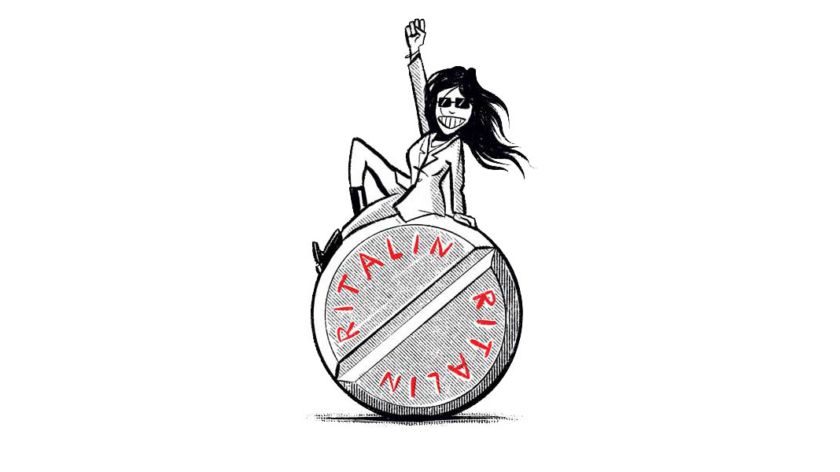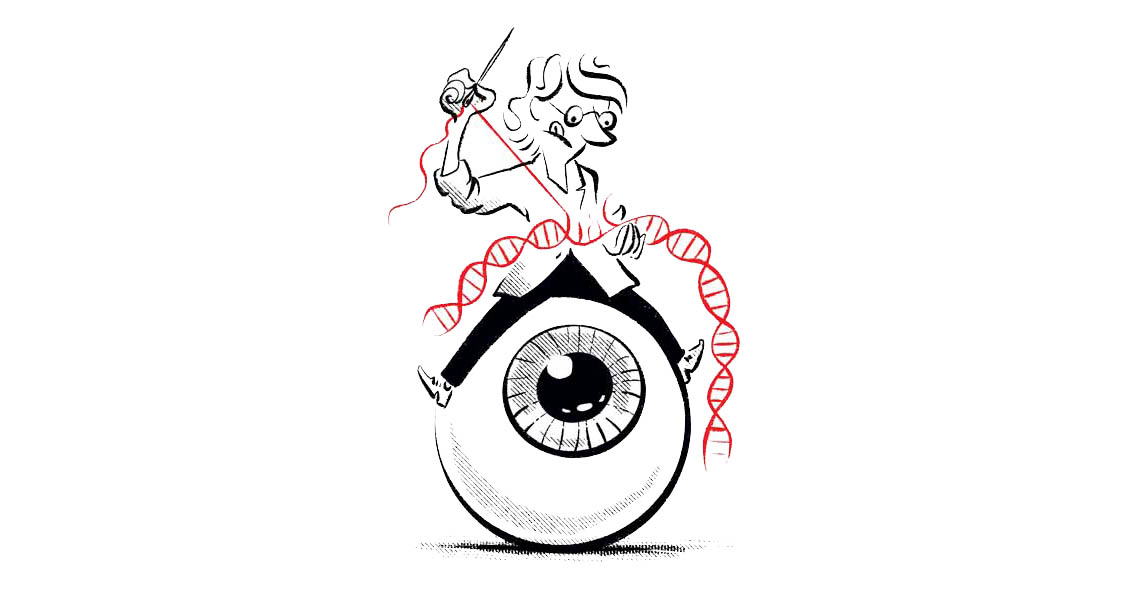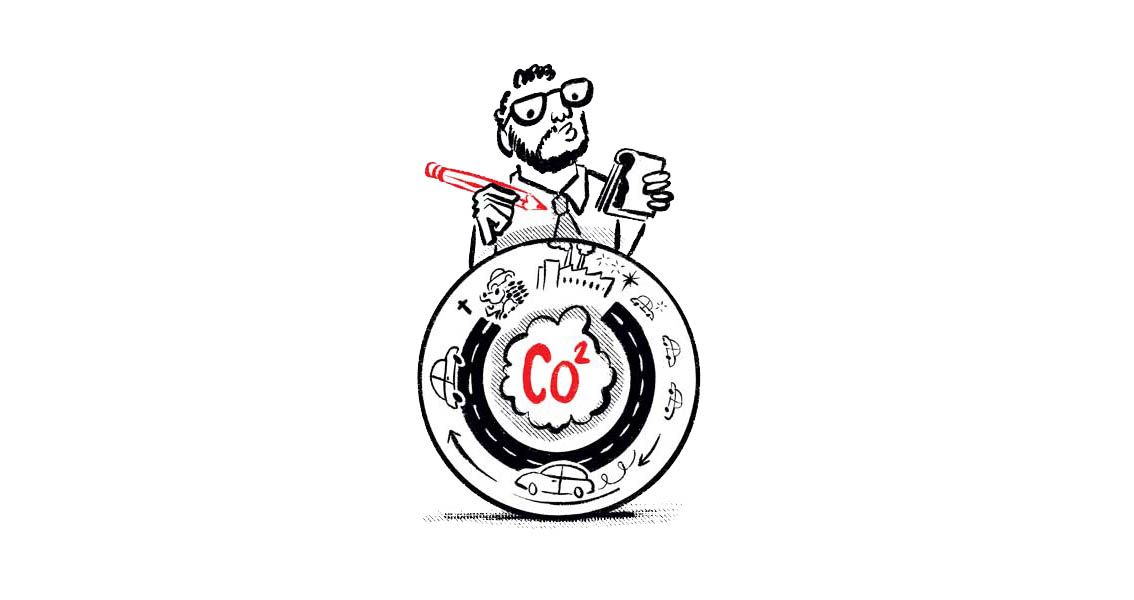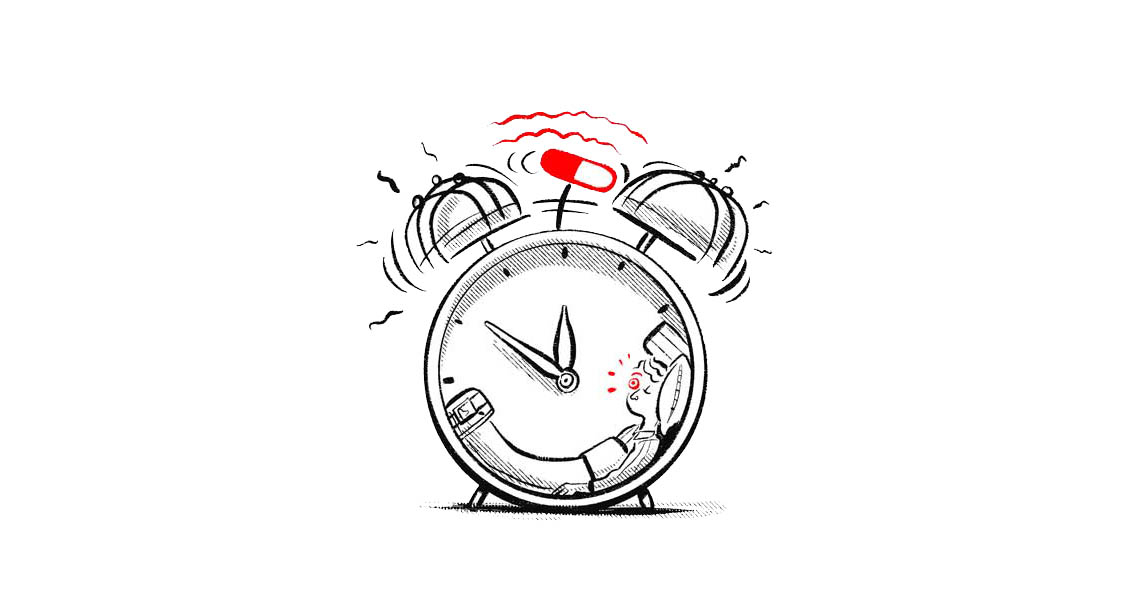These researchers did not work on a vaccine this year
-
 Illustration: Roel Venderbosch
Illustration: Roel Venderbosch
It seemed like science had only one goal this year: a coronavirus vaccine. Luckily, research on other topics has continued where possible. In Nijmegen, researchers celebrated breakthroughs with electric cars, Ritalin, DNA and a miraculous sleeping pill.
Pop a Ritalin pill to perform better during exam week? It works for some people; others don’t notice a thing. Neuroscientists at the Donders Institute discovered why.
Professor Roshan Cools was recently visiting a secondary school with her son when she saw a strip of Ritalin tablets on the floor. ‘My first thought was: are there drug dealers here?’ The pills, originally intended for people suffering from ADHD (mostly children), have become incredibly popular as ‘smart drugs’. They allegedly help students perform better in tests and exams.
Researchers now understand better how methylphenidate (the active ingredient in Ritalin) can help improve performance, thanks to a publication by Cools’ research group last March in the top journal Science. The drug doesn’t make you temporarily smarter, as some think. Rather, it increases motivation, conclude Cools and her postdoc researcher Andrew Westbrook. ‘People are more willing to complete difficult tasks, even for a lower reward.’ A rather spectacular new insight, which unfortunately didn’t get the attention it deserved in the midst of the coronavirus commotion, concludes the Professor of Cognitive Neuropsychiatry.
In the experiment Westbrook asked 50 test subjects to complete easy or difficult memory tasks. For the former they were offered a high reward (say €3), for the latter a lower reward (for example €1). The difficulty level and accompanying rewards varied throughout the experiment. The researchers found that after taking a Ritalin tablet test subjects were more likely to choose a difficult task, even for a lower reward.
Interestingly Ritalin was found to be most effective for test subjects with a naturally low dopamine level. Subjects who had a high level of this substance in their brains were naturally more inclined to choose difficult tasks for less money. This difference may explain why some smart drug users swear by Ritalin, while others hardly notice the effect, says Cools. ‘If your dopamine level is already high, Ritalin doesn’t really add anything.’
But even if you belong to the first group, you shouldn’t buy drugs from schoolyard and campus dealers, says the Professor. ‘Like every drug, Ritalin also has side-effects – it can affect your heart and blood pressure, for example.’

Many members of a single Dutch family are slowly going blind. After 30 years, geneticists at Radboud university medical center discovered the cause: a genetic error that damages the retina.
At first you no longer see the stars at night, then you lose sight during the day, until finally you run the risk of becoming blind. This nightmare – known in medicine as retinitis pigmentosa – is affecting the members of one Dutch family. After 30 years, Radboudumc researchers finally discovered the reason: this family’s DNA contains more than double the number of certain genes.
And this has serious consequences, conclude Radboudumc researcher Susanne Roosing and her PhD student Suzanne de Bruijn. DNA is the string of hereditary material containing approximately 20,000 genes in our cells. It is rolled up into two sets of 23 ‘balls of wool’, the chromosomes. In family members suffering from retinitis pigmentosa this doubling causes the 17th DNA ball to roll up in a slightly different way. As a result, one of the double genes accidentally becomes activated in the retina cells, where it slowly damages the working of the light-sensitive cells that allow us to see.
In mid-March the discovery led to a publication that very nearly made it to the most prestigious of all medical journals. Geneticist Roosing: ‘At the time the editors were flooded with COVID-19 research. In their own words, they received so many submissions that they couldn’t publish everything they wanted.’ In the end the study was published in the American Journal of Human Genetics, another highly renowned journal.
Now that we know which gene is responsible, the Dutch family has hope once again – as do the other 22 families worldwide suffering from the same condition. The researchers can, for example, investigate the possibility of switching off the substance responsible for producing this gene, which may stop the eyesight loss.
Furthermore, members of the Dutch family in question can use embryo selection to prevent the gene – and the eye disease – from being passed on to their children. The chances of inheriting it are currently 25% to 50%, depending on the disease subtype.

Are electric cars really more environmentally friendly if you take into account their production and dismantling? The answer is ‘yes’, claims environmental scientist Florian Knobloch in the Nature study that crowned his PhD research.
Tesla is probably the best-known symbol of progress and environmental awareness. But is this reputation justified? Although driving a Tesla produces zero CO2 emissions, its production cycle and the electricity that powers it are far from fossil-free. Steel production requires high temperatures and a lot of energy, a large portion of which comes from coal and gas power stations. So in what way is it environmentally friendly?
And yet, when you add it all up, electric cars really do score better than diesel or petrol engines in nearly all respects, at least when it comes to greenhouse gas emissions. Only the largest electric cars powered entirely by ‘dirty’ power sources (from coal power stations) perform less well than the smallest most energy-efficient petrol cars. This was the conclusion reached this spring by environmental researcher Florian Knobloch and his colleagues. It led to a publication in Nature Sustainability, in Knobloch’s own words the ‘absolute crowning jewel’ of his PhD dissertation, which he completed this year.
‘A life-cycle analysis is actually the only way to compare products like cars fairly’, explains Knobloch. ‘The reason is that this kind of analysis includes all emissions in the calculation,” from production to driving and finally dismantling. No such analysis had yet been performed on a global scale for electric cars.
Knobloch and his colleagues were also the first to take into account three potential future scenarios for generating renewable power. These varied from very pessimistic (less than now) to largely CO2-free. According to the researchers’ calculations, the Tesla car won even in the worst scenario.
Having said that, you can make transport much more efficient still, Knobloch notes soberly, ‘by not driving at all.’

Nijmegen and Amsterdam researchers made a miraculous discovery. With a sleeping pill they were able to ‘awaken’ a man who had not communicated with his environment for years.
The story of 37-year-old nursing home patient Richard is reminiscent of the film Awakenings (1990). In this film renowned neurologist Oliver Sacks (played by Robin Williams) helps ‘awaken’ catatonic patients in a nursing home in the 1960s. The miracle drug that made this possible was L-dopa, a dopamine-like drug still used to treat Parkinson disease.
Richard had also been unable to communicate with the outside world for many years, after nearly choking to death on a piece of meat and suffering a stroke due to lack of oxygen. ‘It’s called akinetic mutism’, explains Radboudumc geriatric expert Willemijn van Erp. ‘The consciousness of these patients is intact, but they are unable to initiate movement or speak.’ She first met Richard in a nursing home in 2012, shortly after starting on her specialisation and PhD research. ‘He was in a wheelchair, was being fed by tube, and had to be helped with everything. He could hear us, but was unable to respond.’
The situation changed completely when Richard was experimentally administered the sleeping drug Zolpidem. Suddenly he could speak a little and even make a phone call. He was also able to move his arms and walk a short distance. Van Erp’s colleagues from Amsterdam discovered what had happened with the help of brain scans. It turned out that Richard’s brain was overactive and the drug solved this problem. Van Erp: ‘The sleeping drug created room for the kind of brain activity you need to speak and move.’
Is Zolpidem a miracle pill that will awaken people from their coma like the prince in Sleeping Beauty? Unfortunately not, says Van Erp. Richard was a unique case, with a rare kind of brain damage. “But it does show how useful additional techniques, like brain scans, can be in re-examining patients with long-term brain damage. It allows us to better understand what went wrong and what kinds of treatments might be possible, also for people in a nursing home.’
Unlike in Sleeping Beauty, Richard’s revival is unfortunately temporary. As his brain becomes used to the drugs, the effect diminishes over time. The same tragic fate awaited the patients in Awakenings. New treatment possibilities, such as deep brain stimulation, will hopefully lead to lasting improvement. This is what Van Erp and her colleagues hope to investigate in the years to come.



